West Village
The West Village is a neighborhood in the western section of the larger Greenwich Village neighborhood of Lower Manhattan, New York City.[1]

The traditional boundaries of the West Village are the Hudson River to the west, West 14th Street to the north, Greenwich Avenue to the east, and Christopher Street to the south.[1][2][3][4] Other popular definitions have extended the southern boundary as far south as Houston Street, and some use Seventh Avenue or Avenue of the Americas as the eastern boundary.[5][6][7] The Far West Village extends from the Hudson River to Hudson Street, between Gansevoort Street and Leroy Street.[8][9][lower-alpha 1] Neighboring communities include Chelsea to the north, the South Village and Hudson Square to the south, and the Washington Square neighborhood of Greenwich Village to the east.[1][5][11]
The West Village is part of Manhattan Community District 2, and is patrolled by the 6th Precinct of the New York City Police Department.[12] Residential property sale prices in West Village are among the most expensive in the United States, typically exceeding US$2,100 per square foot ($23,000/m2) in 2017.[13]
History
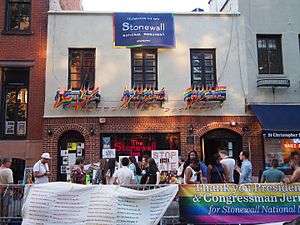
Beginning in the early 1980s, residential development spread in the Far West Village between West Street and Hudson Street, from West 14th Street to West Houston Street, resulting in the area being given its own name.[10]
Preservation
Historically, local residents and preservation groups have been concerned about development in the Village and have fought to preserve the architectural and historic integrity of the neighborhood. More than 50 blocks, bordering 14th Street to the north, comprise a historic district established by the New York City Landmarks Preservation Commission. The district's convoluted borders run no farther south than 4th Street or St. Luke's Place, and no farther east than Washington Square East or University Place. Redevelopment in this area is severely restricted, and developers must preserve the main facade and aesthetics of the buildings, even during renovation. This district—which was for four decades the city's largest—was created in 1969 by the then-four-year-old New York City Landmarks Preservation Commission. However, preservationists advocated for the entire neighborhood to be designated a historic district; although it covers most of the West Village, the blocks closest to the Hudson River are excluded.[16]
Advocates continued to pursue their goal of additional designation, spurred in particular by the increased pace of development in the 1990s. The Greenwich Village Society for Historic Preservation (GVSHP), a nonprofit organization dedicated to the architectural and cultural character and heritage of the neighborhood, successfully proposed new districts and individual landmarks to the LPC. Those include:[17]
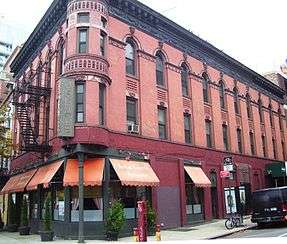
- Gansevoort Market Historic District was the first new historic district in Greenwich Village in 34 years. The 112 buildings on 11 blocks protect the city's distinctive Meatpacking District with its cobblestone streets, warehouses and rowhouses. About 70 percent of the area proposed by GVSHP in 2000 was designated a historic district by the LPC in 2003, while the entire area was listed on the State and National Registers of Historic Places in 2007.[18][19]
- Weehawken Street Historic District, designated in 2006, is a 14-building, three-block district near the Hudson River centering on tiny Weehawken Street and containing an array of architecture including a sailor's hotel, former stables, and a wooden house.[20]
- Greenwich Village Historic District Extension I, designated in 2006, brought 46 more buildings on three blocks into the district, thus protecting warehouses, a former public school and police station, and early 19th-century rowhouses. Both the Weehawken Street Historic District and the Greenwich Village Historic District Extension I were designated by the LPC in response to the larger proposal for a Far West Village Historic District submitted by GVSHP in 2004.[20] The Landmarks Preservation Commission also designated as landmarks several individual sites proposed by the Greenwich Village Society for Historic Preservation, including the former Bell Telephone Labs Complex (1861–1963), now Westbeth Artists Community, designated in 2011;[21] and houses at 159 Charles Street and 354 W. 11th Street, as well as the Keller Hotel, all in 2007.
In addition, several contextual rezonings were enacted in Greenwich Village in recent years to limit the size and height of allowable new development in the neighborhood, and to encourage the preservation of existing buildings. The following were proposed by the GVSHP and passed by the City Planning Commission:
- Far West Village Rezoning, approved in 2005, was the first downzoning in Manhattan in many years, putting in place new height caps, thus ending construction of high-rise waterfront towers in much of the Village and encouraging the reuse of existing buildings.[22]
- Washington and Greenwich Street Rezoning, approved in 2010, was passed in near-record time to protect six blocks from out-of-scale hotel development and maintain the low-rise character.[23]
Reputation as urban bohemia
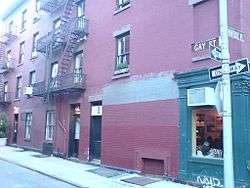
The West Village historically was known as an important landmark on the map of American bohemian culture in the early and mid-twentieth century. The neighborhood was known for its colorful, artistic residents and the alternative culture they propagated. Due in part to the progressive attitudes of many of its residents, the Village was a focal point of new movements and ideas, whether political, artistic, or cultural. This tradition as an enclave of avant-garde and alternative culture was established during the 19th century and into the 20th century, when small presses, art galleries, and experimental theater thrived. Known as "Little Bohemia" starting in 1916,[24] West Village is in some ways the center of the bohemian lifestyle on the West Side, with classic artists' lofts in the form of the Westbeth Artists Community and Julian Schnabel's Palazzo Chupi. It is also the site of sleek new residential towers designed by American architect Richard Meier facing the Hudson River at 173/176 Perry Street.
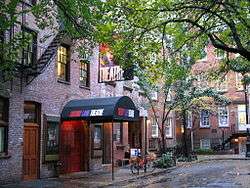
.jpg)
In 1924, the Cherry Lane Theatre was established at 38 Commerce Street. It is New York City's oldest continuously running Off-Broadway theater. A landmark in Greenwich Village's cultural landscape, it was built as a farm silo in 1817, and also served as a tobacco warehouse and box factory before Edna St. Vincent Millay and other members of the Provincetown Players converted the structure into a theatre they christened the Cherry Lane Playhouse, which opened on March 24, 1924, with the play The Man Who Ate the Popomack. During the 1940s The Living Theatre, Theatre of the Absurd, and the Downtown Theater movement all took root there, and it developed a reputation as a place where aspiring playwrights and emerging voices could showcase their work.
On January 8, 1947, stevedore Andy Hintz was fatally shot by hitmen John M. Dunn, Andrew Sheridan and Danny Gentile in front of his apartment on Grove Street. Before he died on January 29, he told his wife that "Johnny Dunn shot me."[25] The three gunmen were immediately arrested. Sheridan and Dunn were executed.[26]
The Village hosted the first racially integrated night club in the United States,[27] when Café Society was opened in 1938 at 1 Sheridan Square[28] by Barney Josephson. Café Society showcased African American talent and was intended to be an American version of the political cabarets Josephson had seen in Europe before World War I. Notable performers there included among others: Pearl Bailey, Count Basie, Nat King Cole, John Coltrane, Miles Davis, Ella Fitzgerald, Coleman Hawkins, Billie Holiday, Lena Horne, Burl Ives, Lead Belly, Anita O'Day, Charlie Parker, Les Paul and Mary Ford, Paul Robeson, Kay Starr, Art Tatum, Sarah Vaughan, Dinah Washington, Josh White, Teddy Wilson, Lester Young, and The Weavers, who also in Christmas 1949, played at the Village Vanguard.
The annual Greenwich Village Halloween Parade, initiated in 1974 by Greenwich Village puppeteer and mask maker Ralph Lee, is the world's largest Halloween parade and America's only major nighttime parade, attracting more than 60,000 costumed participants, 2 million in-person spectators, and a worldwide television audience of over 100 million.[29]
Street grid
The neighborhood is distinguished by streets that are "off the grid", being set at an angle to the other streets in Manhattan. These roads were laid out in an 18th-century grid plan, approximately parallel or perpendicular to the Hudson, long before the Commissioners' Plan of 1811 which created the main street grid plan for later parts of the city. Even streets that were given numbers in the 19th century to make them nominally part of the grid can be idiosyncratic, at best. West 4th Street, formerly Asylum Street, crosses West 10th, 11th and 12th Streets, ending at an intersection with West 13th Street. Heading north on Greenwich Street, West 12th Street is separated by three blocks from Little West 12th Street, which in turn is one block south of West 13th Street. Further, some of the smaller east-west residential streets are paved with setts (often confused with cobblestones), particularly in Far West Village and the Meatpacking District.
This grid is prevalent through the rest of Greenwich Village as well.
Demographics
.jpg)
Based on data from the 2010 United States Census, the population of the West Village neighborhood tabulation area was 66,880, a change of -1,603 (-2.4%) from the 68,483 counted in 2000. Covering an area of 583.47 acres (236.12 ha), the neighborhood had a population density of 114.6 inhabitants per acre (73,300/sq mi; 28,300/km2).[30] The racial makeup of the neighborhood was 80.9% (54,100) White, 2% (1,353) African American, 0.1% (50) Native American, 8.2% (5,453) Asian, 0% (20) Pacific Islander, 0.4% (236) from other races, and 2.4% (1,614) from two or more races. Hispanic or Latino of any race were 6.1% (4,054) of the population.[31]
The approximate residential population in the West Village is 34,000 people based on seven 2010 Census Tracts for Manhattan Community District 2.[32] Some population characteristics include:[33]
- 10% of the population in the West Village is less than 20 years old (27% of population of entire US is less than 20 years old[34])
- 45% of the population in the West Village is 20–39 years old (versus 27% in entire US[34])
- Females aged 20–39 make up 25% of the population in the West Village (13% of population in entire US[34]) Females aged 20–29 make up 14% of the population in the West Village versus 7% in the entire US. Females in West Village represent 52% of the population versus 51% in all of the US.
- 80% of the population was born in the US (87% in entire US[35])
- Average household income by census tract was $180,000 (compared to $51,000 average household income by state for entire US[36])
A study by NYU estimated that 8,000 workers commute to the West Village during the workweek.[37]
About 13,000 out-of-town visitors also visit the neighborhood daily. A portion of these approximately 139,452 domestic and international visitors that enter the city daily[38] visit or stay in the West Village; an average of 11,000 people visit the High Line every day.[39]
Police and crime
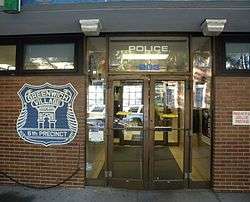
West Village is patrolled by the 6th Precinct of the NYPD, located at 233 West 10th Street.[40] The 6th Precinct ranked 68th safest out of 69 patrol areas for per-capita crime in 2010. This is due to a high incidence of property crime.[41]
The 6th Precinct has a lower crime rate than in the 1990s, with crimes across all categories having decreased by 80.6% between 1990 and 2018. The precinct reported 1 murder, 20 rapes, 153 robberies, 121 felony assaults, 163 burglaries, 1,031 grand larcenies, and 28 grand larcenies auto in 2018.[42]
The Meatpacking District at the north end of this neighborhood, also known as the "Gansevoort Historic District", is filled with trendy boutiques and nightclubs. It is also the area's most concentrated site of grand larceny. (Grand larceny in New York is legally defined as stealing property worth $1,000 or more or property taken from the person of another without the threat of force.)[43] In February 2013 the NYPD passed out 3,500 fliers to bars and clubs in the Sixth Precinct warning people to guard their valuables, especially at district's clubs, due to the rise in grand larceny rates.[44] Police have said these crimes mostly happen in the Meatpacking District from 11 p.m. to 3 a.m.[45]
Fire safety
West Village is served by two New York City Fire Department (FDNY) fire stations:[46]
Post office and ZIP Codes
West Village is located within two primary ZIP Codes. Most of West Village, south of Greenwich Avenue and west of Sixth Avenue, is located in 10014, while the northern section north of Greenwich Avenue is in 10011.[49] The United States Postal Service operates the West Village Station post office at 527 Hudson Street.[50]
Education
Schools
There are two zoned elementary schools nearby: PS 3 Melser Charrette School, and PS 41 Greenwich Village School. Residents are zoned to Baruch Middle School 104. Greenwich Village High School was a private high school formerly located in the area, but later moved to SoHo. In 2017, Middle School 297 opened at 75 Morton Street.[51]
Libraries

The New York Public Library (NYPL) operates two branches near West Village. The Jefferson Market Library is located at 425 Avenue of the Americas (Sixth Avenue). The building was a courthouse in the 19th and 20th centuries before being converted into a library in 1967, and it is now a city designated landmark.[52] The Hudson Park branch is located at 66 Leroy Street. The branch is housed in Carnegie library that was built in 1906 and expanded in 1920.[53]
Transportation
The area is served by the M8, M11, M14A, M20, M55 New York City Bus routes and the following New York City Subway stations:
- 14th Street–Eighth Avenue at Eighth Avenue; serving the A, C, E, and L trains
- West Fourth Street–Washington Square at Sixth Avenue; serving the A, B, C, D, E, F, <F>, and M trains
- 14th Street at Seventh Avenue; serving the 1, 2, and 3 trains
- Christopher Street–Sheridan Square at Seventh Avenue; serving the 1 and 2 trains
- Houston Street at Varick Street; serving the 1 and 2 trains
West Village is also served by the PATH at Christopher Street and 9th Street.[54]
The Citi Bike bike share program launched in the area in May 2013.[55]
Points of interest
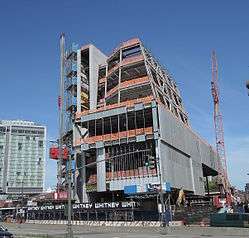
- The Jefferson Market Branch of the New York Public Library is at 425 Sixth Avenue, corner of West 10th Street. It was built as a courthouse from 1874 to 1877, and was designed by architect Frederick Clarke Withers of the firm of Vaux and Withers. It was turned into a library after public outcry over its planned demolition in 1958.[56]
- The High Line, now a public park, connects the historic district to Chelsea, Hell's Kitchen, and the Hudson Yards Redevelopment Project. The elevated train tracks, mostly running parallel to Tenth Avenue, have been converted to an open greenway. The tracks, abandoned in 1980, once served the businesses in the area; the park opened in 2009.[57]
- The Hudson River Park, running from 59th Street to the Battery including most of associated piers, is being transformed into a joint city/state park with non-traditional uses.
- The St. Luke in the Fields Church is an Episcopal church founded in 1820 on farmland donated by Trinity Church.[58]
- The Stonewall Inn is a gay tavern and recreational bar. It is most famous as the site of the Stonewall riots of 1969, which is widely considered to be the single most important event leading to the gay liberation movement and the modern fight for gay and lesbian rights in the United States.[59] The surrounding area is designated as the Stonewall National Monument.
- The Village Vanguard is a jazz club opened on February 22, 1935, by Max Gordon. At first, it featured many forms of music, such as folk music and beat poetry, but it switched to an all-jazz format in 1957.
- The Westbeth Artists Community is a nonprofit housing and commercial complex dedicated to providing affordable living and working space for artists and arts organizations. The complex is named for two of the streets that border it—West and Bethune.[60]
- The new Whitney Museum of American Art is located in the West Village. The Whitney was founded in 1931 by Gertrude Vanderbilt Whitney, a wealthy and prominent American socialite and art patron. Its permanent collection comprises more than 21,000 works. From 1966 to 2014, the Whitney was located on the Upper East Side; it closed in October 2014 to relocate to a new building in the Meatpacking District/West Village, which opened in May 2015.[61]
Notable residents
Costas Kondylis's 1 Morton Square residential development (on Morton and West Street, completed in 2004) is the residence of actresses Mary-Kate and Ashley Olsen[62] and of actor Daniel Radcliffe.[63] Richard Meier's towers at 173 Perry Street, 176 Perry Street, and 165 Charles Street are home to actors Jim Carrey, Hugh Jackman, and Nicole Kidman.[64][65] Other notable actors who currently or formerly resided in the neighborhood include Matthew Broderick, Scarlett Johansson, Ray Romano, Jason Biggs, Ryan Eggold, Andy Samberg, Claire Danes, Hugh Dancy, Will Ferrell,[66] Jill Hennessy, Seth Meyers, Julianne Moore, Sarah Jessica Parker, Brooke Shields, Liv Tyler,[67][68] Saoirse Ronan,[69] Karlie Kloss, and musician/actor Richard Barone [70]
Notes
- There is some ambiguity in the boundaries of the Far West Village, due to variations in block-by-block character – some exclude the 3 north-south blocks from Morton Street (north) to Houston Street (south), and some include the 2 blocks from Hudson Street (west) to Bleecker Street (east) between Bank Street (north) and Christopher Street (south).[10]
References
- Alfred Pommer & Eleanor Winters (2007). Exploring the Original West Village. The History Press. pp. 12–13. ISBN 978-1609491512.
It is a roughly trapezoidal area, bounded on the north by Fourteenth Street, on the south by Christopher Street, on the east by Greenwich Avenue and on the west by the Hudson River. ... Greenwich Village these days also includes two areas to the east, one historically known as the Central Village or Washington Square....
- Jackson, Kenneth T., ed. (2010). The Encyclopedia of New York City (2nd ed.). New Haven: Yale University Press. p. 2588. ISBN 978-0-300-11465-2.. "Those seeking refuge fled north to the wholesome backwaters of the West Village (one of the oldest quarters of Greenwich Village, bounded by Greenwich Avenue, Christopher Street, and West Street), triggering the construction of temporary housing as well as banking offices."
- Goldstein, Joseph (August 8, 2010). "New York neighborhood border wars". New York Post. Retrieved March 15, 2018.
- Neighborhood Guide: West Village
- Jack Finnegan (2011). Newcomer's Handbook For Moving to and Living in New York City. First Books. p. 36. ISBN 978-1609491512.
Because the area is essentially an assembly of small communities—the predominantly Italian South Village, the central Washington Square neighborhood, and the West Village, bounded by Seventh Avenue and the Hudson River—searching for rentals is best done on foot and through reliable real estate agents.
- Wilson, Claire. "Neighborhoods: The West Village". topics.nytimes.com (The New York Times Company). Retrieved March 31, 2014.
- "West Village map". Retrieved March 13, 2018.
- Cheslow, Jerry (April 18, 1993). "If You're Thinking of Living in: Far West Village". The New York Times. Retrieved March 31, 2014.
- COMMUNITY BOARD 2 MANHATTAN: STATEMENT OF NEEDS, Fiscal Year 2009
- Johnston, Laurie (April 18, 1982). "The Far West Village". The New York Times. Retrieved August 22, 2009.
- Community Board No. 2 (map), accessed July 29, 2018
- "NYC Planning | Community Profiles". communityprofiles.planning.nyc.gov. New York City Department of City Planning. Retrieved March 18, 2019.
- "Real Estate Overview for West Village, New York, NY". Trulia.com. Retrieved June 30, 2016.
- "Workforce Diversity The Stonewall Inn, National Historic Landmark National Register Number: 99000562". National Park Service, U.S. Department of the Interior. Retrieved May 1, 2011.
- Eli Rosenberg (June 24, 2016). "Stonewall Inn Named National Monument, a First for the Gay Rights Movement". The New York Times. Retrieved June 25, 2016.
- "Landmark Maps: Historic District Maps: Manhattan". Nyc.gov. Archived from the original on September 9, 2010. Retrieved September 21, 2010.
- "Progress on Landmark and Zoning Protections in the Far West Village 2001–2008" (PDF). Greenwich Village Society for Historic Preservation. Retrieved September 19, 2014.
- "Blood on the Street, and it's Chic". The New York Times. September 11, 2003. Retrieved March 4, 2014.
- "Gansevoort Historic District Gets Final Approval From City". The Villager. Retrieved March 4, 2014.
- The Observer. "Village Historic District Extension". Retrieved March 4, 2014.
- "City Dubs Westbeth a Landmark". The Villager. Retrieved March 4, 2014.
- "City, Landmarks Looking to Rezone Part of West Village". The Sun. Retrieved March 4, 2014.
- Crain's NY Business. "Council Approves 2 Village Rezonings". Retrieved March 4, 2014.
- (nd) Greenwich Village East and West - History and Legacies Archived December 9, 2013, at the Wayback Machine. Arts and Music Pennsylvania. Retrieved June 17, 2007.
- "National Affairs: A Date at The Dance Hall". Time.com. March 7, 1949. p. 1.
- "National Affairs: A Date at The Dance Hall". Time.com. March 7, 1949. p. 2.
- William Robert Taylor, Inventing Times Square: commerce and culture at the crossroads of the world 1991:176
- Many sources give the address at 2 Sheridan Square: "Barney Josephson, Owner of Cafe Society Jazz Club, Is Dead at 86", The New York Times; see history of "The theater at One Sheridan Square" Archived October 11, 2016, at the Wayback Machine
- Village Halloween Parade. "History of the Parade". Archived from the original on July 27, 2014. Retrieved July 28, 2014.
- Table PL-P5 NTA: Total Population and Persons Per Acre - New York City Neighborhood Tabulation Areas*, 2010, Population Division - New York City Department of City Planning, February 2012. Accessed June 16, 2016.
- Table PL-P3A NTA: Total Population by Mutually Exclusive Race and Hispanic Origin - New York City Neighborhood Tabulation Areas*, 2010, Population Division - New York City Department of City Planning, March 29, 2011. Accessed June 14, 2016.
- "Manhattan CD 2 Profile" (PDF). Nyc.gov. Archived from the original (PDF) on February 20, 2014. Retrieved February 2, 2014.
- "American FactFinder". Web.archive.org. February 12, 2011. Archived from the original on October 10, 2011. Retrieved November 2, 2017.CS1 maint: BOT: original-url status unknown (link)
- "National Characteristics: Vintage 2011". census.gov. Retrieved February 2, 2014.
- "The Foreign-Born Population in the United States: 2010" (PDF). Census.gov. Archived from the original (PDF) on February 9, 2015. Retrieved June 30, 2016.
- "Income Statistics - U.S Census Bureau". census.gov. Retrieved February 2, 2014.
- Mitchell L. Moss; Carson Qing (March 2012). "The Dynamic Population of Manhattan" (PDF). Wagner.nyu.edu. Archived from the original (PDF) on April 25, 2012. Retrieved June 30, 2016.
- "NYC & Company: The Official Marketing, Tourism and Partnership Organization for the City of New York". Nycandcompany.orn. Retrieved February 2, 2014.
- "Park Information - Friends of the High Line". thehighline.org. Retrieved February 2, 2014.
- "NYPD – 6th Precinct". www.nyc.gov. New York City Police Department. Retrieved October 3, 2016.
- "Greenwich Village – DNAinfo.com Crime and Safety Report". www.dnainfo.com. Retrieved October 6, 2016.
- "6th Precinct CompStat Report" (PDF). www.nyc.gov. New York City Police Department. Retrieved July 22, 2018.
- "Article 155 - New York State Penal Law Code - Larceny". ypdcrime.com. January 20, 2014. Retrieved February 2, 2014.
- "Alleged Stolen Phone Seller Busted at 6th Avenue Tattoo Shop". dnainfo.com. Archived from the original on February 21, 2014. Retrieved February 2, 2014.
- "iPhone bar thefts have sent Village crime rate soaring". thevillager.com. Retrieved February 2, 2014.
- "FDNY Firehouse Listing – Location of Firehouses and companies". NYC Open Data; Socrata. New York City Fire Department. September 10, 2018. Retrieved March 14, 2019.
- "Engine Company 24/Ladder Company 5/Battalion 2". FDNYtrucks.com. Retrieved March 14, 2019.
- "Squad 18". FDNYtrucks.com. Retrieved March 14, 2019.
- "Greenwich Village, New York City-Manhattan, New York Zip Code Boundary Map (NY)". United States Zip Code Boundary Map (USA). Retrieved March 21, 2019.
- "Location Details: West Village". USPS.com. Retrieved March 7, 2019.
-
- "From a Joke, a School Is Born in the Village" Archived December 2, 2016, at the Wayback Machine, New York Times, September 18, 2008
- "Parents ‘work hard and take a risk’ to form a high school" Archived September 1, 2013, at the Wayback Machine, The Villager, September 24, 2008
- "New private high school find home in Soho on Vandam St." Archived March 3, 2016, at the Wayback Machine, The Villager, November 21, 2008
- "About the Jefferson Market Library". The New York Public Library. Retrieved March 14, 2019.
- "About the Hudson Park Library". The New York Public Library. Retrieved March 14, 2019.
- Maps and Schedule, Port Authority of New York and New Jersey. Accessed June 25, 2019.
- "Citi Bike - Your bike sharing system in New York City". citibikenyc.com. Retrieved February 2, 2014.
- White, Norval; Willensky, Elliot & Leadon, Fran (2010). AIA Guide to New York City (5th ed.). New York: Oxford University Press. p. 144. ISBN 978-0-19538-386-7.
- F. Green & C. Letsch (September 21, 2014). "New High Line section opens, extending the park to 34th St". Daily News. Retrieved September 21, 2014.
- Dunlap, David W. From Abyssinian to Zion: A Guide to Manhattan's Houses of Worship Archived December 7, 2016, at the Wayback Machine. (New York: Columbia University Press, 2004.) p. 223.
- National Park Service (2008). "Workforce Diversity: The Stonewall Inn, National Historic Landmark National Register Number: 99000562". US Department of Interior. Retrieved January 21, 2013.
- Bosh, Clemen (June 8, 1968). "The Talk of the Town: Westbeth". The New Yorker.
- Ellie Stathaki (October 16, 2013), Under Construction: The Whitney Museum's new HQ by Renzo Piano in New York Archived February 19, 2015, at the Wayback Machine Wallpaper.
- "Olsen Twins Sell—Finally—at 1 Morton Square for $7.7 M." September 20, 2010.
- Barbanel, Josh (February 24, 2008). "Daniel Radcliffe Buys Second New York City Apartment - A Real Estate Sequel" – via NYTimes.com.
- Knowawall. "Richard Meier & Partners Architects LLP". richardmeier.com. Archived from the original on September 25, 2010. Retrieved February 2, 2014.
- Knowawall. "Richard Meier & Partners Architects LLP". richardmeier.com. Archived from the original on September 25, 2010. Retrieved February 2, 2014.
- "Vornado's Steve Roth Sells West Village Loft for Four Times What He Paid". observer.com. Retrieved February 2, 2014.
- "Celebrity Homes In The West Village". Business Insider. September 28, 2012. Retrieved February 2, 2014.
- "NYC Celebrity Star Map 2014 - Where Celebrities Live in New York City". rentenna.com. January 20, 2014. Archived from the original on January 10, 2013. Retrieved February 2, 2014.
- "Saoirse Ronan on Brooklyn, her stage debut, why moms know best and returning to New York". Time Out. February 16, 2016. Retrieved February 22, 2016.
External links
| Wikimedia Commons has media related to West Village. |
- Gansevoort Historic District
- Wikipages West Village, a wiki-based business directory for the West Village